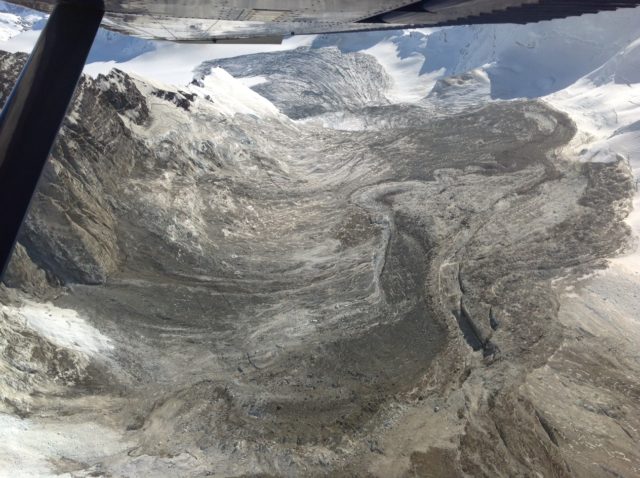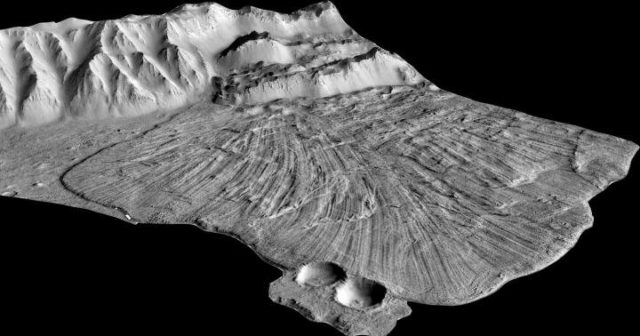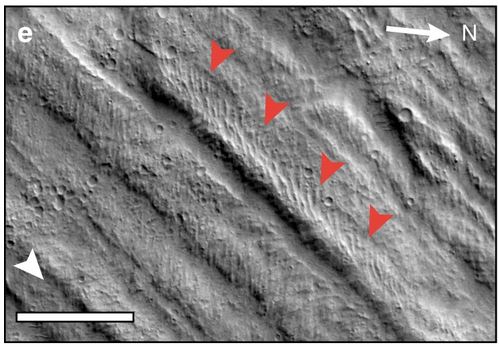29 October 2019
Landslide movement mechanisms: evidence from longitudinal ridges on Mars
Posted by Dave Petley
Landslide movement mechanisms: evidence from longitudinal ridges on Mars
It is well established that some very rapid rock avalanches develop longitudinal ridge structures. A beautiful example is the Mount La Perouse rock avalanche in Alaska, as shown in the image below:-

Longitudinal ridges on the Mount La Perouse rock avalanche in Alaska. The ridge structures are clear on the lowest part of the avalanche deposit in the distance. Image by Marten Geertsema.
.
These longitudinal ridges are only seen in very large landslides, and they are present on deposits from mass movements on Earth and on other planetary bodies. Clearly the formation of these structures is indicative of the internal dynamics of the landslide, but their formation has been difficult to understand.
On Earth, such features are most frequently seen in deposits on glaciers. This has led to the proposal that they are associated with flow over low friction surfaces, such as ice or soft (deformable) sediments. The ridges probably form because the avalanche behaves in a manner similar to a fluid, allowing turbulent processes to develop, generating convection cells in the flowing mass. These observations have in turn been applied to the interpretation of large landslides on Mars, for which the presence of longitudinal ridges has been taken to infer that the landslide has flowed over an icy substrate. The apparent presence of this ice clearly has important implications.
However, in a study just published in Nature Communications (and available open access), Magnari et al. (2019) have examined a very large rock avalanche at Coprates Labes, located in Valles Marineris on Mars. This is beautiful landslide deposit – from source to toe it is over 50 kilometres long:-

Longitudinal ridges on the vast landslide on Coprates Labes, located in Valles Marineris, Mars. Image via Phys.org, by Magnarini et al. (2019).
.
This landslide clearly displays spectacular longitudinal ridges. Magnari et al. (2019) measured the size and shape of the ridges in this landslide deposit, and have analysed the more subtle morphology of the deposit, most notably en echelon structures superimposed on the ridges themselves, as shown below:-

En echelon structures, indicated by the orange arrowheads, superimposed onto the longitudinal ridges on the rock avalanche on Mars. Image from Magnarini et al. (2019).
.
Magnari et al. (2019) note that these more subtle, but clearly evident, features have also been seen in laboratory experiments in rapid granular flows. In the experiments, these features did not require the presence of ice to form. Therefore, they conclude that the presence of longitudinal ridges should not be taken to infer that ice is a prerequisite for the development of these landslides on Mars.
Whilst in many ways the dynamics of landslides on Mars may seem to be a comparatively obscure topic, the analysis of these features casts a light on the mechanisms of landslides on Earth. Most importantly, this study provides further evidence that the movement mechanisms of these giant landslides may be associated with turbulent granular processes in the flowing landslide mass. As these very dynamic landslides become more common in response to global heating, this is an important input to our ability to assess the hazard that they may pose.
Reference
Magnarini, G., Mitchell, T.M., Grindrod, P.M., Goren, L. and Schmitt, H.H. 2019. Longitudinal ridges imparted by high-speed granular flow mechanisms in martian landslides. Nature Communications, 4711 (10). https://doi.org/10.1038/s41467-019-12734-0.


 Dave Petley is the Vice-Chancellor of the University of Hull in the United Kingdom. His blog provides commentary and analysis of landslide events occurring worldwide, including the landslides themselves, latest research, and conferences and meetings.
Dave Petley is the Vice-Chancellor of the University of Hull in the United Kingdom. His blog provides commentary and analysis of landslide events occurring worldwide, including the landslides themselves, latest research, and conferences and meetings.
While those ridges are interesting, I wouldn’t use those ridges to say there is [was] water on Mars…
1) Even if you need [water-based] ice to lower the friction to form these ridges when gravity is 9.8 m/s/s, I expect that for some lower value for gravity, the ridges could form without ice.
2) Dry ice (CO2) could explain these on Mars. And we know the atmosphere is mostly CO2, and the temperature at the poles is already cold enough to freeze it.